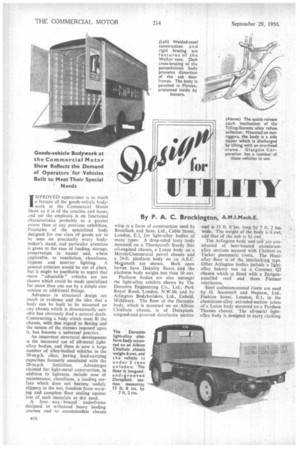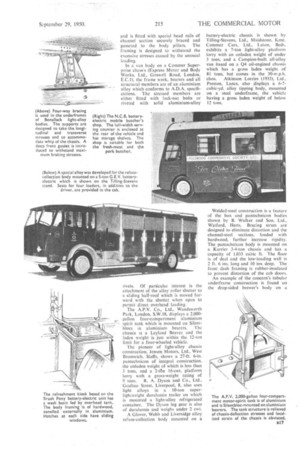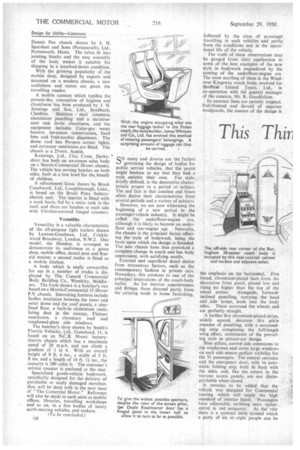By P. A. C. Brockington, A.M.I.Mech.E. I MPROVED appearance is as
Page 50

Page 51

Page 52

If you've noticed an error in this article please click here to report it so we can fix it.
much a featore of the goods-veh:cle bodywork at the Commercial Motor Show as it is of the coaches and buses, and yet the emphasis is on functional characteristics probably to a greater extent than at any previous exhibition. Examples of the specialized body designed for one class of goods are to be seen on practically every bodymaker's stand, and particular attention is given to the ease of loading, storage, preservation in transit and, where applicable, to ventilation, cleanliness, hygiene and interior lighting. A general criticism would be out of place, but it might be justifiable to regret that more "adaptable" vehicles are not shown which could be made specialized for more than one use by a simple conversion or additional fittings.
Advances in structural design are much in evidence and the idea that a body can be built to be mounted on any chassis which is dimensionally suitable has obviously died a natural death. Constructing a body which must fit the chassis, with due regard to flexing and the nature of the stresses imposed upon it, has become a universal practice.
An important structural development is the increased use of all-metal lightalloy bodies, and there is now a large number of alloy-bodied vehicles in the 30-m.p.h. class, having load-carrying capacities formerly associated with the 20-m.p.h. limitation. Advantages claimed for light-metal construction, in addition to lightness, include ease of maintenance, cleanliness, a loading surface which does not become unduly slippery in the wet, freedom from warping and complete floor sealing against loss of such materials as dry sand.
A four way braced underframe designed to withstand heavy loading etresses and to accommodate chassis whip is a form of construction used by Bonallack and Sons, Ltd., Cable Street, London, E.1, for light-alloy bodies of many types. A drop-sided lorry body mounted on a Thornycroft Sturdy Star oil-engined chassis, a Luton body on a Morris-Commercial petrol chassis and a 24-ft. platform body on an A.E.C. Maipmoth are shown. Both open lorries have Dekaloy floors and the platform body weighs less than 10 cwt.
Platform bodies are also amongst the light-alloy exhibits shown by The Duramin Engineering Co., Ltd., Park Royal Road, London, N.W.10, and by Arlington Bodybuilders, Ltd., Enfield, Middlesex. The floor of the Duramin body. which is mounted on an Albion Chieftain chassis, is of Duraplank tongued-and-grooved duralumin section and is 13 ft. 6 ins, long by 7 ft. 2 ins. wide. The weight of the body is 6 cwt. and that of the cab is 3i cwt.
The Arlington body and.cabeare constructed of heat-treated aluminiumalloy sections secured with Chobert-or Tucker pneumatic rivets. The Huntalloy floor is of the interlocking type. Other Arlington bodies include a lightalloy bakery van on a Cornmer Q2 chassis which is fitted with a Perspexpanelled roof and three Fkttner ventilators.
Steel cadmium-coated rivets are used by G. Scammell and Nephew, Ltd., Fashion Street, London, E.I, in the aluminium-alloy extruded-section joints of a Luton body mounted on a Fordson Thames chassis. The all-metal lightalloy body is designed to carry clothing and is fitted with special head rails of channel section securely braced and gusseted to the body pillars. The framing is designed to withstand the excessive stresses caused by the unusual loading.
In a van body on a Comrrter Superpoise chassis (Express Motor and Body Works, Ltd., Goswell Road. London, E.C.1), the frame work. bearers and all structural members are of an aluminium alloy which conforms to A.D.A. specifications. The stressed members are either fitted with lock-nut bolts or riveted with solid aluminium-alloy rivets. Of particular interest is the attachment of the alloy roller shutter to a sliding half-roof which is moved forward with the shutter when open to permit direct overhead loading.
The A.P.V. Co., Ltd., Wandsworth Park, London, S.W.18, displays a 2.000gallon four-compartment aluminium spirit tank which is mounted on Silentblocs in aluminium bearers. The chassis is a Leyland Beaver and the laden weight is just within the 12-ton limit for a four-wheeled vehicle.
The pioneer of light-alloy chassis construction, Jensen Motors, Ltd., West Bromwich, Staffs, shows a 27-ft. 6-in. pantechnicon of integral construction, the unladen weight of which is less than 3 tons, and a 2-t5n 16-cwt. platform lorry with a gross-weight rating of 9 tons. R, A. Dyson and Co., Ltd., Grafton Street, Liverpool, 8, also uses light alloys in a 10-ton superlightweight duralumin trailer on which is mounted a light-alloy refrigerated container. The Dyson leg gear is also of duralumin and weighs under 2 cwt.
A Glover, Webb and Liversidge alloy refuse-collection body mounted on a battery-electric chassis is shown by Tilling-Stevens, Ltd., Maidstone. Kent. Commer Cars, Ltd., Luton, Beds. exhibits a 7-ton light-alloy platform lorry with an unladen weight of under 3 tons, and a Campion-built all-alloy van based on a Q4 oil-engined chassis which has a gloss laden weight of 8/ tons, but comes in the 30-m .ph.
class. Atkinson Lorries (1933), Ltd.. Preston, Lanes, also displays a (-7cubic-yd. alloy tipping body, mounted on a steel underframe, the vehicle having a gross laden weight of below 12 tons.
Welded-steel construction is a feature of the box and pantechnicon bodies shown by B. Walker and Son. Ltd., Watford, Herts. Bracing struts are designed to eliminate distortion and the channel-steel sections, loaded with hardwood, further increase rigidity. The pantechnicon body is mounted on a Karrier 3-4-ton chassis and has a capacity of 1.035 cubic ft. The floor is of deal and the low-loading well is 2 ft. 6 ins, long and 10 ins. deep. The front dash framing is rubber-insulated to prevent distortion of the cab doors.
An example of the concern's tubular underframe construction is found on the drop-sided brewer's body on a Dennis Pax chassis shown by J. H. Sparshatt and Sons (Portsmouth), Ltd.. Portsmouth, Hants. The tubes fit into jointing blocks and the easy assembly of the body makes it suitable for shipping in a knocked-down condition.
With the growing popularity of the mobile shop, designed by experts and mounted on a modern chassis, a new usefulness and status are given the travelling vendor.
A mobile canteen which typifies the present-day conception of hygiene and cleanliness has been produced by J. H. Jennings and Son, Ltd., Sandbach, Cheshire. Stainless steel counters, aluminium panelling and a stainlesssteel sink invite cleanliness, and the equipment includes Calor-gas water heaters,. ice-cream conservators, food bins and fruit-cordial dispensers. The dome roof has Perspex corner lights, and extractor ventilators are fitted. The chassis is a 25-cwt. Austin.
Kennings, Ltd., Clay Cross, Derbyshire, has built an ice-cream sales body on a Morris-Commercial 10-cwt. chassis. The vehicle has serving hatches on both sides, built at a low level for the benefit of children.
A refreshment kiosk shown by Brush Coachwork, Ltd., Loughborough, Leics., is based on the Brush Pony batteryelectric unit. The interior is fitted with a wash basin, fed by a water tank in the roof, and there are hatches at each side with Vitrohte-covered hinged counters.
Versatility Versatility is a valuable characteristic of the all-purpose light trailers shown by Lawton-Goodman. Ltd., Cricklewood Broadway, London, N.W.2. One model, the Hendon, is arranged to demonstrate its usefulness as a gown shop, mobile office, dental post and firstaid station; a second trailer is fitted as a mobile kitchen.
A body which is easily convertible for use in a number of trades is displayed by The Cunard Commercial Body Building Co., Wembley, Middlesex. The form shown is a butcher's van based on a Morris-Commercial 15-20-cwt P.V. chassis. Interesting features include lsoflex insulation between the inner and outer dome and the roof panels, a zinclined floor, a built-in aluminium ventilating duct in the canopy, Flettner ventilators. a clerestory roof and toughened-glass side windows.
The butcher's shop shown by Smith's Electric Vehicles, Ltd., Gateshead, 11, is based on an N.C.B. 30-cwt. batteryelectric chassis which has a maximum speed of 20 m.p.h. and can climb a gradient of 1 in 4. With an overall height of 8 ft. 6 ins.. a width of 5 ft. 8 ins, and a length of 14 ft. l ins., the . capacity is 280 cubic ft. The customer's service counter is enclosed at the rear.
Specialized goods-vehicle bodywork, specifically designed for the delivery of perishable or easily damaged merchandize, will be dealt with in the next issue of "The Cornercial Motor." Reference will also be made to such units as mobile offices. libraries,, travelling workshops and so on, to a few bodies of heavy earth-moving vehicles, and tankers.
(To be concluded.)




























































































